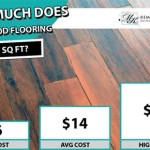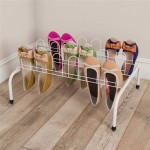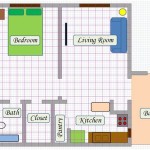Flooring Options for White Kitchen Cabinets
White kitchen cabinets remain a consistently popular choice for homeowners due to their clean, bright aesthetic and versatility. However, selecting the right flooring to complement white cabinets is crucial to achieving a cohesive and visually appealing kitchen design. The floor not only serves a functional purpose but also contributes significantly to the overall style and ambiance of the space. Considerations should extend beyond aesthetics to encompass durability, maintenance requirements, and budgetary constraints.
This article examines various flooring materials that effectively pair with white kitchen cabinets, detailing their properties, advantages, and potential drawbacks. The goal is to provide a comprehensive overview to assist homeowners in making informed decisions that align with their specific needs and preferences.
Hardwood Flooring: A Classic Choice
Hardwood flooring offers a timeless elegance that complements white kitchen cabinets beautifully. Its natural warmth and texture can soften the starkness of white, creating a welcoming and inviting atmosphere. Hardwood comes in a wide variety of wood species, each with unique grain patterns, colors, and hardness levels, allowing for customization to match specific design aesthetics. Options range from light-colored woods like maple and ash, which enhance the brightness of the kitchen, to darker woods like walnut and oak, which create a more dramatic contrast.
Engineered hardwood is another viable option. It consists of a thin layer of hardwood veneer bonded to a core of plywood or other composite material. Engineered hardwood offers greater stability and resistance to moisture than solid hardwood, making it a suitable choice for kitchens where spills and humidity are common occurrences. While both solid and engineered hardwood offer durability, their susceptibility to scratches and water damage necessitate careful maintenance. Regular sweeping and mopping, along with prompt cleanup of spills, are essential. Applying a protective finish can also enhance its resistance to wear and tear.
The cost of hardwood flooring varies depending on the wood species, grade, and installation complexity. It typically falls in the mid-to-high price range compared to other flooring options. However, its longevity and aesthetic appeal often make it a worthwhile investment for homeowners seeking a classic and durable flooring solution for their white kitchen.
Tile Flooring: Durability and Versatility
Tile flooring represents a practical and stylish choice for kitchens, offering exceptional durability and a wide range of design possibilities. It is resistant to water, stains, and scratches, making it ideal for high-traffic areas prone to spills. Tile is available in various materials, including ceramic, porcelain, and natural stone, each with its own characteristics and price points.
Ceramic tile is a cost-effective option that offers a wide variety of colors, patterns, and sizes. It is relatively easy to install and maintain, making it a popular choice for budget-conscious homeowners. Porcelain tile, denser and less porous than ceramic, offers superior durability and water resistance. It can mimic the appearance of natural stone, wood, or other materials, providing a versatile and aesthetically pleasing flooring solution. Natural stone tile, such as granite, marble, and travertine, offers a luxurious and timeless look. However, it typically requires more maintenance and is more expensive than ceramic or porcelain tile.
When paired with white cabinets, tile flooring can create a variety of design styles. Light-colored tiles, such as white, cream, or beige, enhance the brightness of the kitchen and create a seamless and airy feel. Dark-colored tiles, such as gray, black, or brown, provide a striking contrast and add visual interest. Patterned tiles can add personality and character to the kitchen, while neutral-colored tiles offer a versatile backdrop that complements various design schemes. One potential drawback of tile flooring is its hardness, which can be uncomfortable underfoot. Radiant floor heating can mitigate this issue, providing warmth and comfort during colder months. Grout lines, also, require regular cleaning and sealing to prevent staining and mildew growth.
Luxury Vinyl Flooring: A Practical Alternative
Luxury vinyl flooring (LVF) has emerged as a popular alternative to hardwood and tile, offering a combination of durability, aesthetics, and affordability. LVF consists of multiple layers, including a wear layer, a decorative layer, and a backing layer. The wear layer protects the floor from scratches, stains, and wear, while the decorative layer provides a realistic image of wood, stone, or other materials. The backing layer provides support and stability.
LVF comes in two main formats: luxury vinyl planks (LVP) and luxury vinyl tiles (LVT). LVP mimics the appearance of hardwood planks, while LVT mimics the appearance of tiles. Both LVP and LVT are available in a wide range of colors, patterns, and textures, allowing for customization to match specific design preferences. LVF is waterproof and stain-resistant, making it ideal for kitchens where spills and moisture are common. It is also relatively easy to install and maintain, requiring only regular sweeping and mopping.
When paired with white cabinets, LVF can create a variety of design styles. Light-colored LVF can enhance the brightness of the kitchen and create a seamless and airy feel. Dark-colored LVF can provide a striking contrast and add visual interest. LVF that mimics the appearance of hardwood can add warmth and texture to the kitchen, while LVF that mimics the appearance of stone can add a touch of elegance. While LVF offers numerous advantages, it is important to choose a high-quality product with a thick wear layer to ensure durability and longevity. The quality of the printing, or decorative layer, is also essential for the realism of the flooring.
Concrete Flooring: Industrial Chic
Concrete flooring has gained popularity as a modern and industrial-chic option for kitchens. It offers a sleek and minimalist aesthetic that complements white cabinets beautifully. Concrete is durable, long-lasting, and relatively low-maintenance. It can be stained, polished, or sealed to achieve a variety of finishes and colors.
Polished concrete provides a smooth and glossy surface that is resistant to stains and scratches. Stained concrete allows for customization of the floor color to match specific design preferences. Sealed concrete protects the floor from moisture and staining. Concrete flooring can be paired with radiant floor heating to provide warmth and comfort during colder months. When paired with white cabinets, concrete flooring can create a modern and sophisticated look. Light-colored concrete can enhance the brightness of the kitchen, while darker concrete can add a touch of drama.
One potential drawback of concrete flooring is its hardness, which can be uncomfortable underfoot. Area rugs can be used to soften the floor and add warmth to the space. Concrete is also prone to cracking, particularly in areas with significant temperature fluctuations. Proper installation and sealing are essential to minimize the risk of cracking. While concrete is a very durable material, it is also porous and susceptible to grease, so regular cleaning is necessary.
Cork Flooring: Sustainable and Comfortable
Cork flooring is a sustainable and eco-friendly option that offers unique comfort and insulation properties. Made from the bark of the cork oak tree, it's a renewable resource. Cork flooring is naturally resilient, providing cushioning underfoot, making it comfortable to stand on for extended periods. It also has excellent sound absorption qualities, reducing noise levels in the kitchen.
Cork flooring comes in tiles or planks and is available in various colors and patterns, ranging from natural tones to more vibrant shades. It can be sealed to protect against moisture and stains, making it suitable for kitchen environments. When paired with white cabinets, cork flooring can add warmth and texture to the kitchen. Lighter shades of cork can enhance the brightness, while darker shades can provide a subtle contrast.
While cork flooring is relatively durable, it is softer than hardwood or tile and can be susceptible to scratches and dents from heavy objects or sharp heels. Regular sweeping and mopping, along with the use of furniture pads, can help to protect the floor. It is also important to choose a high-quality cork flooring product with a durable sealant to ensure longevity. The environmental benefits of cork are significant, and with proper care, it can be a long-lasting and aesthetically pleasing choice.
Linoleum Flooring: Another Eco-Friendly Option
Linoleum flooring is another eco-friendly flooring option made from natural materials such as linseed oil, rosin, cork dust, wood flour, and pigments. It is a durable and sustainable choice that has been used for over a century. Linoleum is naturally antibacterial and biodegradable, making it a healthy and environmentally responsible option for the kitchen.
Linoleum is available in a wide range of colors, patterns, and designs, allowing for customization to match specific design preferences. It is also relatively easy to install and maintain, requiring only regular sweeping and mopping. When paired with white cabinets, linoleum flooring can create a variety of design styles, from classic to contemporary. Bold colors and patterns can add a playful touch to the kitchen, while neutral colors provide a versatile backdrop.
While linoleum is durable, it can be susceptible to scratches and dents from sharp objects. It is also important to choose a high-quality linoleum flooring product that is properly sealed to prevent moisture damage. The initial cost of linoleum flooring can be higher than some other options, but its longevity and environmental benefits make it a worthwhile investment for many homeowners. Like cork, its natural antibacterial properties make it a uniquely hygienic choice for the kitchen.
Selecting the Right Flooring Color and Texture
Beyond the material itself, the color and texture of the flooring play a significant role in the overall aesthetic of the kitchen. When working with white cabinets, the flooring can serve as either a complementary element that enhances the brightness and airiness of the space or a contrasting element that adds visual interest and depth.
Light-colored flooring, such as white, cream, or light gray, can create a seamless and spacious feel. This is particularly effective in smaller kitchens or kitchens with limited natural light. Dark-colored flooring, such as black, dark brown, or dark gray, can provide a striking contrast and add a touch of drama. This approach works well in larger kitchens with ample natural light. Mid-tone flooring, such as beige, tan, or medium gray, offers a versatile option that complements a variety of design styles. It provides a balance between light and dark, creating a warm and inviting atmosphere.
The texture of the flooring also contributes to the overall aesthetic. Smooth flooring, such as polished concrete or glossy tile, creates a sleek and modern look. Textured flooring, such as hardwood with a pronounced grain or tile with a natural stone finish, adds visual interest and depth. Ultimately, the choice of flooring color and texture depends on the homeowner's personal preferences and the desired overall style of the kitchen. Considering the interplay between the flooring, cabinets, countertops, and backsplash is crucial to creating a cohesive and harmonious design.

Should Your Kitchen Cabinets Match Flooring

How Wood Flooring Warms Up A White Kitchen

How To Match Kitchen Floors And Cabinets Twenty Oak

What Color Floors Go With White Cabinets 50floor

What Color Floors Go Best With White Kitchen Cabinets Home Decor Christy

Can You Have White Cabinets With Espresso Hardwood Floors

How Wood Flooring Warms Up A White Kitchen

What Color Cabinets Go With White Tile Floor Design Tips

5 Kitchen Floors That Go Perfectly With White Cabinets The Diy Mommy

Timeless Elegance Design A Kitchen With Brown Floors Reallycheapfloors America S Cheapest Hardwood Flooring







